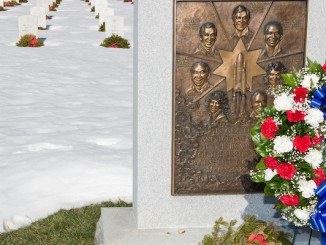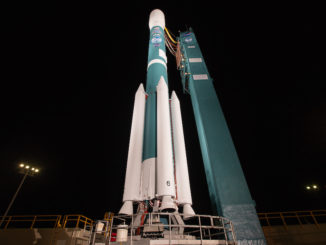On the 50th anniversary of the launch pad fire that killed the Apollo 1 astronauts, an immersive exhibit area paying tribute to the three men has opened at Kennedy Space Center Visitor Complex’s Saturn V Center.
Called “Ad Astra Per Aspera – A Rough Road Leads to the Stars,” the permanent exhibition carries the blessings of the families of Apollo 1 astronauts Gus Grissom, Ed White II and Roger Chaffee. It showcases clothing, tools and models that define the men as their parents, wives and children saw them as much as how the nation viewed them.
The tribute also displays for the first time the three-section hatch from the Apollo 1 capsule that caught fire at Launch Complex 34 on Jan. 27, 1967. The astronauts were not able to escape the smoke and blaze inside the spacecraft before they asphyxiated despite their own efforts and those of numerous pad crew members who braved thick fumes and scorching temperatures to try to get the men out.
“Although the fire took place across the river on Launch Pad 34, their story didn’t end there and their legacy lives on today,” said Sheryl Chaffee, daughter of Roger Chaffee.
“Ultimately, this is a story of hope, because these astronauts were dreaming of the future that is unfolding today,” said former astronaut Bob Cabana, center director at Kennedy. “Generations of people around the world will learn who these brave astronauts were and how their legacies live on through the Apollo successes and beyond.”
For Grissom, one of NASA’s Original Seven astronauts who flew the second Mercury mission, a hunting jacket and a pair of ski boots are on display, along with a small model of the Mercury spacecraft and a model of an F-86 Sabre jet like the one he flew in the Korean War. There is also a slide rule and engineering drafts that typify his dedication to detail.
The small handheld maneuvering thruster that Ed White II used to steer himself outside his Gemini capsule during the first American spacewalk features prominently in a display case of the West Point graduate whose athletic prowess nearly equaled his flying acumen. An electric drill stands alongside the “zip gun,” as he called the thruster.
Roger Chaffee, for whom Apollo 1 would have been his first mission into space, was an esteemed Naval aviator who became a test pilot in his drive to qualify as an astronaut later. Displayed are board games like those he played with his wife and kids on rare evenings free of training.
After seeing the hatches, visitors will walk through a gateway and down the same metal walkway astronauts used later to get to the Apollo spacecraft as it stood on a Saturn V rocket poised for the moon.
“Grissom, White, Chaffee, President Kennedy – I think these names are appropriately mentioned together,” said Michael Collins, the command module pilot for Apollo 11. “Apollo 1 tragically cost three lives, but I think it saved more than three lives later. Without it, very likely we would’ve not landed on the moon by the end of the decade.”



